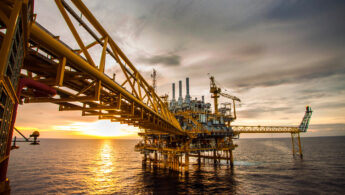Azerbaijan’s energy and climate policies dominated by gas export expansion plans
Azerbaijan's climate and renewable energy efforts are dwarfed by its gas export expansion plans.

Gas demand forecasting is crucial for efficient planning of gas supply systems. International agencies, private sector forecasters, industry operators and governments develop forecasts to prepare to meet future energy needs, underpinned by their particular objectives.
Between 2015 and 2023, the International Energy Agency (IEA) lowered its 2040 base-case (STEPS)[1]The Stated Policies Scenario (STEPS) reflects the current policy settings based on sector-by-sector and country-by-country assessment of energy-related policies that are in place as of the end of … Continue reading gas demand forecast by over 1,500 billion cubic metres (bcm), aligning with the pace of the energy transition. These adjustments have been particularly significant in the last several years, with projected gas demand in 2050 falling 18% between its 2021 and 2023 forecast, which now expects gas demand to peak by 2030.
This is particularly relevant for Asia, which is expected to lead global gas consumption through 2050, generating some 75% of demand for liquified natural gas (LNG)[2]Liquified natural gas (LNG) is natural gas that has been reduced to a liquid state through a process of cooling., but where the falling costs of renewables alongside rising energy security concerns have prompted many countries to reconsider their future energy mix.
Gas demand trajectories vary widely due to regional and temporal differences in the transition away from fossil fuels. Factors to consider when assessing the accuracy of gas demand forecasts include:
The primary target for gas demand until 2040 has shifted from mature to emerging Asian markets. Forecasters cite factors such as coal-to-gas fuel switching in key emerging markets to support this view of rising demand dynamics. However, there is a risk that narratives of overall regional demand growth overlook the concurrent fall in Japan and South Korea, the second- and third-largest Asian LNG importers in 2023. Japan’s LNG demand alone is forecast to drop by one third of 2019 levels by 2030 if government targets are met.
The two countries will look to emerging LNG markets in South and Southeast Asia to offload excess gas supply, meeting rising demand in emerging Asia as domestic gas reserves in these countries decline, but not necessarily contributing to an absolute rise in consumption across Asia at the level expected by many forecasts
Any proportional rises in the region’s largest economies – China and India, the first and third largest by GDP in 2022 – will equate to enormous regional growth in absolute terms, notwithstanding falling demand in mature markets.
China and India will remain the frontrunners for LNG use under current demand scenarios. Despite this, there are signals that China’s gas demand may not be as high as some anticipate given the government’s focus on energy security. With a potential policy capping LNG dependence at 40%, and the country aiming to keep its energy self-dependence rate above 80%, China is building its shift towards renewable energy. Since 2015, natural gas generation has remained flat at around 3%, while coal dropped and renewables nearly quadrupled to 16%. In India, gas demand is growing, but is uncompetitive with coal in the power sector, which will be a limiting factor until this dynamic changes.
While gas use in the power sector faces headwinds, industrial demand in China and India is also likely to remain robust. This is especially true for sectors that already use gas as a feedstock, such as fertilisers in India. The growth for gas in industry is not projected to be as strong as the power sector, but its trajectory will likewise depend on the changing dynamics of the cost of different energy technologies.
The majority of Asian gas demand is in the form of LNG, and most countries are net importers, with the notable exceptions of Malaysia and Indonesia, according to Bloomberg.
New growth in LNG demand is being attributed to emerging economies, notably Southeast Asian entrants, historically not major LNG consumers. This speculative demand is expected to feed the power sector as these countries experience economic growth until the mid-century.
However, this demand may not materialise. Regulatory hurdles and delays in countries such as the Philippines and Vietnam have meant that projected demand has so far not been met, while in Taiwan, persistent terminal delays as well as financial difficulties may limit a rapid increase in LNG imports. Importantly, if the price does not meet the competitive threshold in these countries, LNG will no longer be competitive.
In light of these realities, some industry forecasts – mainly originating from Western markets and key LNG suppliers – are scaling back medium-term demand projections. Notably, Shell slashed its global LNG demand expectation for 2040 by up to 11% compared to previous forecasts.
Industry players expect the power sector will be the primary sector driving gas demand. However, it is important to question whether LNG will be competitive for baseload power generation compared to other energy sources.
Especially as domestic reserves are depleted and reliance on LNG rises, there is a looming risk that gas will not remain cost-competitive with cheaper, locally abundant energy sources. This could lead to backsliding to more dependence on coal in some countries, such as India where coal represented 55% of energy consumption in 2022, but conversely could also see a stronger uptake in wind and solar. Here, India is targeting around 50% of power generation from non-fossil fuel sources by 2030.
The IEA attributes the gas demand destruction behind its falling forecasts to the rise of renewable energy as a power generation source and to improved energy efficiency, particularly in mature markets. Solar costs in APAC fell by 23% on average in 2023 alone, helping to drive expansion. Wood Mackenzie likewise found that utility solar PV was the cheapest source of power in the Asia Pacific in 2023.
The dynamics of levelised cost of electricity (LCOE)[3]The LCOE is the long-term offtake price that a developer needs to recoup all project costs (capex, opex, tax, financing) and hit the investment target (cost of equity). Cost estimates from market … Continue reading, a standardised cost metric for power generation over a project’s lifetime, is changing as technology develops. The LCOE of renewables is rapidly coming down, which will affect their cost competitiveness to gas over the forecast period.
China and India, anticipated to be the two largest contributors to gas demand until 2050, currently boast lower LCOE for solar than for combined cycle gas turbines. In the second half of 2023, China’s lowest LCOE for solar PV was USD 31 /megawatt hour (MWh), compared to USD 72 /MWh for gas. In India, the lowest LCOE for solar PV was USD 26 /MWh, compared to USD 86 /MWh for gas. Solar LCOE across Asia is projected to plummet further by 2050, contrasting with gas prices remaining stagnant.
Even without considering alternatives, reliance on LNG imports, especially for price-sensitive markets, has prompted a number of governments in the region to consider energy security when designing their future energy mix.
China and India have signed a slew of long-term LNG contracts in a bid to secure energy supplies. Although contracts dominate LNG trade flows in Asia, price-sensitive LNG buyers such as China, India and parts of Southeast Asia will continue to grapple with fluctuating prices on the market-driven spot market, which account for around 23% of gas sales. Late or missed shipments can also severely impact local energy supply.
LNG spot market prices are only cost competitive under a certain threshold, determined by market dynamics in each country. In India, the energy ministry puts this threshold at USD 11/million British thermal units (mmBtu). In 2023, Asian LNG spot market prices averaged USD 17.68 /mmBtu, above the competitive threshold for India and most other South and Southeast Asian countries, which led to power cuts and blackouts in the region. In August 2022, the spot price shot up to USD 70 /mmBtu, an empirical example of how LNG is fiscally unsustainable in regional emerging markets.
Even long-term LNG deals do not guarantee protection for emerging Asian countries such as Pakistan, due to unfavourable terms being exploited. Bloomberg revealed that despite a contract being signed during the 2022 energy crisis, cancelled deliveries forced Pakistan to buy LNG on the spot market, resulting in factory closures and increased poverty. Investing in renewable energy offers sovereignty within energy systems and mitigates climate impacts such as extreme heat and pollution in these nations.
This analysis examined 12 significant Asian countries across East, Southeast and South Asia, with a view to gain insights into the gas landscape across the entire region. In 2022, these 12 countries accounted for just under 770 bcm of gas consumption, representing about 90% of total gas consumption in Asia.
References
| ↑1 | The Stated Policies Scenario (STEPS) reflects the current policy settings based on sector-by-sector and country-by-country assessment of energy-related policies that are in place as of the end of August 2023. |
|---|---|
| ↑2 | Liquified natural gas (LNG) is natural gas that has been reduced to a liquid state through a process of cooling. |
| ↑3 | The LCOE is the long-term offtake price that a developer needs to recoup all project costs (capex, opex, tax, financing) and hit the investment target (cost of equity). Cost estimates from market researcher BNEF reflect recently financed projects; we model LCOEs assuming financing in 2023. |

Azerbaijan's climate and renewable energy efforts are dwarfed by its gas export expansion plans.

Although carbon capture and storage could help reduce emissions, most projects are connected to the production of more oil and…